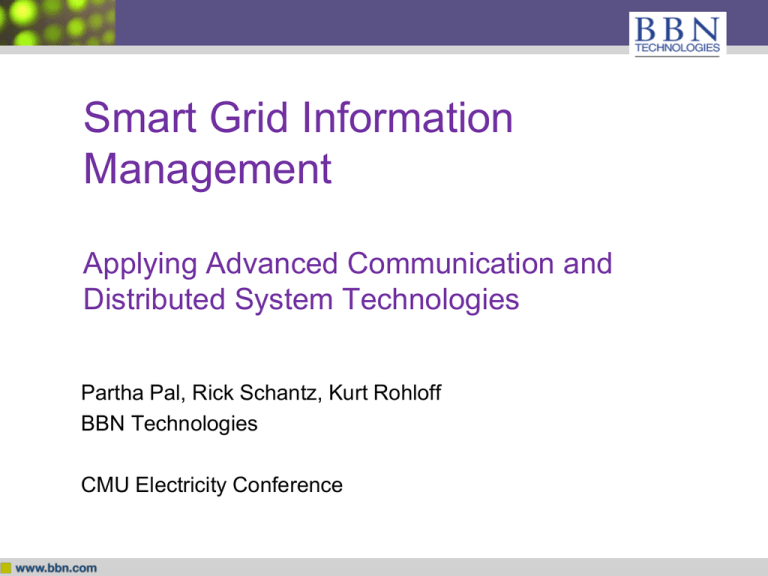Smart Grid Information Management Applying Advanced Communication and Distributed System Technologies
advertisement

Smart Grid Information Management Applying Advanced Communication and Distributed System Technologies Partha Pal, Rick Schantz, Kurt Rohloff BBN Technologies CMU Electricity Conference Outline • Introduction • BBN • Application of advanced communication and distributed systems technology in smart grids • Conclusion Introduction At the core of the Smart Grid vision is development and adoption of technology to collect, transport, store and analyze information about electricity condition and usage….. GridWise 2006 Panel on Smart Grid Example features of a smart grid: Advanced metering, Demand Response, Energy intelligence, Advanced control, Asset management/business optimization…. (EnerNOC documentation) • Modern smart grid must be able to heal itself, motivate consumers to actively participate in operations of the grid, resist attack, provide higher quality power that will save money wasted from outages, accommodate all generation and storage options, enable electricity markets to flourish, run more efficiently.. (NETL, DoE 2007) Information system characteristics – Resilient (tolerant, survivable): failures and attacks – Trustworthy and collaborative: – Adaptive: autonomic and proactive Smart Grids need Smart Information Systems We’ve seen this before: network centric systems, information centricity… BBN and Evolution of Distributed Systems 1950s 1960s 1970s 1980s 1990s 2000s • Over 700 employees • HQ in Cambridge, MA with offices in Arlington, VA; Columbia, MD; Minneapolis, MN; Middletown, RI; O’Fallon, IL & a subsidiary in San Diego, CA Emb. Emb. • 2/3 of BBN employees have advanced degrees App App App App App App App App Application Application • Interest spans from computing and information technology to physical MW LW MiddleMiddle- MW MW Middle- LW Middle- MW MiddleMiddlesciences ware ware Svcs Svcs ware ware Svcs Svcs ware ware OS OS Operating • Specializes in Embedded Embedded OS OS System OS OS OS OS Network Developing technology enablers (R&D) Protocols Networkdemonstrations Advanced technology concept Network Protocols Network Protocols App App Custom solutions to hard problems Protocols Operating System Programming Languages Database Systems Database Systems System Development Environments Information Management Systems BBN is continuing to contribute key networking and distributed systems technologies Network protocols, distributed OS, middleware & middleware services, DRE, survivable systems, semantic web… An Information Centric View • (Grid) Information management – Collection: what needs to be collected – Transportation: where to, how fast – Storage: where, how much, how long • (Grid) Information services – Business logic: how to process, what to produce – Building the new services There are a number of unique challenges that the information system architecture must address • QoS and Security – Information transport – Information processing • Separation of concern – Electrical/Business domain experts generate requirements for computer scientists, network and security engineers • Requirements and Technology both are evolving – Ad-hoc approaches will lead to a messy, brittle and costly solution (Information) Technology Centric View • Information Transport – Topology/network architecture – IP, GigE, Optical networks – Encoding, protocols vs. services (and legacy protocols) • Information Storage – Cloud – Identifiers and other metadata – Relational databases, digital objects, semantic storage • Information processing – – – – Objects, Components, Services Persistence vs. streams/events Adaptive and adaptation control Multi-core vs. cell, virtualization • QoS and Security – Mission/application oriented adaptive QoS – Survive in addition to prevent or detect Will focus on advanced transport and survivability only in this talk Advanced Transport Services • Envisioned Smart Grid information internetwork will have – – – Multiple types of services with specific QoS (loss rate, latency, capacity..) and security Multiple types of transport (packets, circuits, various types of multiplexing), Multiple modes (wireless, leased, fibers, tunneling through the public Internet) Cost of ownership, management… Evolution … Secure… Each “application” managing its own communication Applications plug into a wellmanaged network The current situation has many ingredients that may cause the grid information system of the future to look like the current Internet: applications that are locally adapted to communicate over the network, patchwork of interconnections without a holistic view of the entire system– an integrated architecture combining electrical as well as information system aspects–and how it may evolve in the future ….. Advanced Transport (contd.) Emerging technologies provide new transport capabilities; we should be aware of, and be prepared to take advantage of these We are implementing these capabilities in the context of a high speed, high capacity optical network (PHAROS) • Network architecture: 10x/100x Subscriber Services (BE IP, Guaranteed IP, l) Path Computation Signaling Network Element Configuration PHAROS Setup Time PIP Requirement (CONUS) T1 R1 T2 R2 T3 R3 T4 R4 T5 R5 T6 R6 1 1 2 2 3 3 4 4 5 5 6 6 7 7 8 8 9 9 10 10 11 11 12 12 13 13 14 14 15 15 16 16 17 17 10x/100x PHAROS Edge Slow Client Optical Switch 18 18 19 19 20 20 21 21 22 22 23 23 24 24 25 25 26 26 27 27 28 28 29 29 30 30 31 31 32 32 33 33 34 34 T1 R1 T2 R2 T3 R3 T4 R4 IP Router T1 R1 T2 R2 T3 R3 T4 R4 T5 R5 T6 R6 1 1 2 7 7 8 2 3 3 4 4 5 5 6 6 8 9 9 10 10 11 11 12 12 T1 R1 T2 R2 T3 R3 T0 R0 T1 R1 T2 R2 T3 R3 T4 R4 T5 R5 T6 R6 T7 R7 T8 R8 T9 R9 SLG Switch DWDM Transport T1 R1 T2 R2 T3 R3 R0 T0 R1 T1 R2 T2 R3 T3 R4 T4 R5 T5 R6 T6 R7 T7 R8 T8 R9 T9 IP Services l Services Sub l IP:ODUk 2 2 3 3 4 4 5 5 6 6 7 7 8 8 9 Full l IP:ODUk Groomed Transit 9 10 10 11 11 12 12 13 13 Groomed Transit + Local OEO Regen/l Conv Core Optical Switch c1 c2 c3 c4 c1 c2 c3 c4 c1 c2 c3 c4 c1 c2 c3 c4 c1 c2 c3 c4 c1 c2 c3 c4 c1 c2 c3 c4 c1 c2 c3 c4 OSC In FIBER 4R FIBER 3R FIBER 3T Optical Amplifier Shelf FIBER 2R Out OCM OSC OSC In Out FIBER 4T In OCM Out OCM In FIBER 2T Out OSC 1 FIBER 1T 1 FIBER 1R PHAROS Core Fast Optical Switch OCM – Adapters (a necessity for interoperation and relatively routine) – Topology Abstractions: innovative view of the network based on adjacencies at various levels – Resource allocation algorithms: use the abstractions to decide how to set up a path or route – Fast signaling to enable mesh routing and dynamic reconfigurations – Authentication/authorization /encryption: security association at the network level Optical Bypass Available Resource Inactive Resource 1:n TR Protect VFSS (ms) 10 35 <50 95 100 Leveraging the Network • Creation of abstractions appropriate for the application and its context – Programming – Services • Availability of high speed, high capacity, security-enabled, robust and dynamically provisioned network makes it easy to construct valueadded middleware – multicast, probabilistic multicast, pub-sub, distributed queues, federations – High assurance dissemination – Timeliness and QoS adaptive • Availability of value-added middleware in turn is required for costeffective and rapid implementation of the desired business logic – – – – The application does not need to worry about transport issues Simpler implementation Faster time to marked “evolution ready” Survivable Information Systems • Intrusion Tolerant Systems: – Resiliency against failures in the information domain • Natural (fault tolerance) as well as attack-induced Nature of attacks – Access– enabler of further actions Defense mechanisms: • • Exfiltration, Corruption – Denial by consumption Security tools and mechanisms to prevent, detect and recover from specific attacks or attack classes • Firewalls, crypto, redundancy React • Requires minimal access.. Detect Protect Attacks – Crash • Can be caused by physical attacks – Corruption • Can be caused by insiders System Network Host Survivability architecture: • Organizing multiple layers of defense chosen based on the need Management of defenses: • Control loops connecting the defense mechanisms Validation/certification/accreditation • Invariants and “trusted” enforcement Process Application App. JVM CSA/SELinux ADF VPN Firewall Switches Redundancy/Diversity BBN developed (and validated) defense mechanisms, survivability architecture and cognitive management in various DARPA projects Conclusion • Smart Grid without a smart Information System is untenable – Electrical/power and business domain will generate requirements for the information system • The Information System must be “future proof” and “evolution ready” – New technologies – New requirements, usages • Current technology and business environment is conducive to incremental and patchwork solutions – That will be a BIG mistake • BBN’s past experience in networking and distributed systems innovation prompts us to recognize the need of a big picture – Integrated electrical and information system architecture – Evolving technologies and requirements – Over space, over time, not just grids, but inter-grid, possibly across national boundaries BBN brings the information system perspective and expertise, need collaborative interactions with the community to develop and articulate a smooth transition to the big picture view



